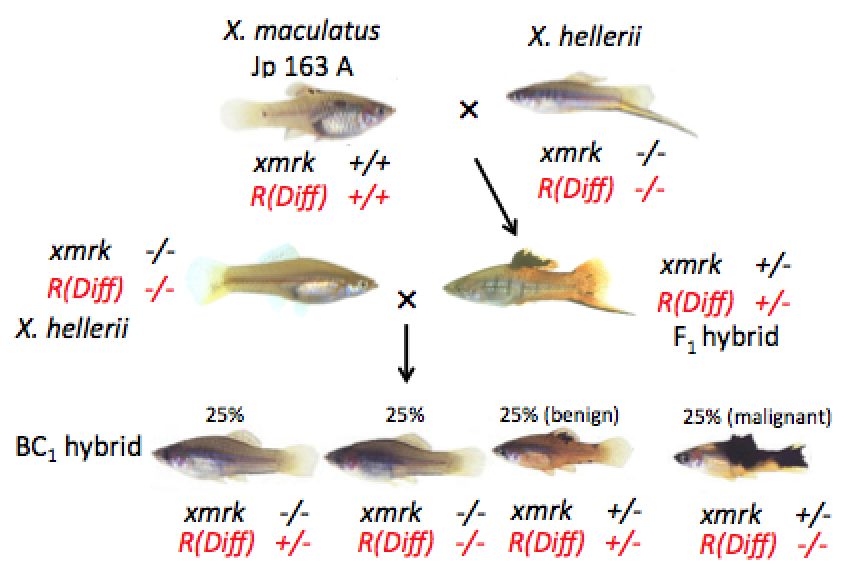From Mendelian inheritance to Xiphophorus model system
Congshan Li, April 2017
3402 Bioinformatics Group

The Xiphophorus is a genus of teleost fish discovery in Mexico. The Xiphophorus includes platy fish and swordtail. What is best known for the Xiphophorus in biomedical research is interspecies hybrid between certain Xiphophorus species lead to malignant melanoma. The Xiphophorus melanoma is a long-standing unique genetic model, with distinct melanoma phenotypes (i.e. benign lesions and malignant tumor) as a result of inheritance of a Xiphophorus maculatus (X. maculatus) specific xmrk oncogene in different genetic backgrounds (i.e., R(Diff) +/- or R(Diff) -/-).
The most well studied Xiphophorus melanoma model is a result of genetic interaction between two loci after an interspecies backcross [X. hellerii x (X. maculatus Jp 163 A x X. hellerii)]. The highly inbred (<110 generations) X. maculatus parental line is homozygous for the spotted dorsal (Sd) macromelanophore pigmentation pattern leading to melanization of the dorsal fin. The Sd pattern is tightly linked to an oncogene, xmrk (Xiphophorus melanoma regulatory kinase) that is kept in check by a melanoma suppressor function, R(Diff). The xmrk oncogene is mapped to sex chromosome by Dr. Manfred Schartl in 1989, and the R(Diff) locus is mapped to a 5.8Mb locus on chromosome 5 by Dr. Yuan Lu and Dr. Ron Walter in 2017. X. maculatus (x) X. hellerii F1 interspecies hybrids, having a single copy of xmrk and R(Diff), one observes enhanced dorsal fin macromelanophore pigmentation, but this does not develop into invasive melanoma. However, when the F1 hybrid (Sd-hellerii) is backcrossed with X. hellerii, 25% of progeny that inherit the xmrk oncogene, but do not also inherit an X. maculatus R(Diff), spontaneously develop invasive, melanoma tumors.
The driver oncogene in the Xiphophorus melanoma model, xmrk, is a mutant fish egfr gene. Under the normal circumstances, Receptor Tyrosine Kinases (RTKs) are activated upon dimerization of egfr following ligand binding. However, the mutant xmrk auto-dimerizes and activates in a ligand-independent manner. Two mutations (C578S and G359R) responsible for spontaneous activation of xmrk are involved in intramolecular disulfide bonding. The effects of mutations that form or stabilize a dimeric conformation of EGFR family proteins and other RTKs were also shown in human and other animal models. Introduction of an additional cysteine near the human EGFR transmembrane domain is enough to increase receptor dimerization. EGFR is frequently mutated in different types of cancers (e.g., 10-47% in non-small cell lung cancer; 50% in malignant glioma; 8%-13% in prostate cancer; 11.4% in triple-negative breast cancer) including the mutations enhancing ligand-independent receptor dimerization and is highly expressed in the majority of human carcinomas. For example: on average, 50-70% of lung, colon, and breast cancers express EGFR. Both anti-EGFR monoclonal antibodies and anti-EGFR small-molecule tyrosine kinase inhibitors (TKIs) exhibit promising therapeutic effects, rendering EGFR one of the most studied molecular targets in cancer research. However, accompanying this increasing interest in targeting EGFR in cancer therapy is the finding of tumors resistant to EGFR inhibitors. EGFR mutation/deletion, activation of bypass pathways, and activation of EGFR downstream pathways all serve as mechanisms accounting for the TKI resistance. Therefore, identification of a reliable next generation treatment strategy that enables disease control without tumor relapse for EGFR driven cancer is of utmost importance. The R(Diff) locus is capable of functionally repressing the mutant EGFR activity without disease recurrence. Therefore defining the R(Diff) locus and identifying gene(s) that account for the R(Diff) function can forward our molecular genetic understanding of the xmrk-R(Diff) to further mechanistic studies.
The oncogene regulatory function of the R(Diff) locus cannot be compensated by any other genetic or environment factors. Unlike transgenic model systems, which heavily rely on known disease mechanisms for testing new hypothesis, the genetic interactions required in the Xiphophorus melanoma model represent molecular mechanism of disease that occur in nature, and do not any prior understanding of the disease mechanism. Therefore understanding the genetic interactions of this model will forward our current knowledge of disease etiology. The oncogenic nature of the mutant egfr (i.e., Xiphophorus xmrk gene), provides a natural model system to identify the mechanism of the R(Diff) oncogene regulator in the Xiphophorus genome. The value of characterizing the molecular genetic features of R(Diff) will not only will benefit cancer etiology research, but also expand the overall understanding of EGFR regulation. In the short term, deciphering this genetic interaction may lead to insight in potential tumorigenic mechanisms. In the long term, fully understanding the mechanisms of R(Diff) regulation of xmrk may lead to discovery of a novel EGFR regulatory mechanisms, and potential new applications to human cancer research.
References:
- Lu Y, Boswell M, Boswell W, Kneitz S, Hausmann M, et al. (2017) Molecular genetic analysis of the melanoma regulatory locus in Xiphophorus interspecies hybrids. Mol Carcinog.
- Wittbrodt J, Adam D, Malitschek B, Maueler W, Raulf F, et al. (1989) Novel putative receptor tyrosine kinase encoded by the melanoma-inducing Tu locus in Xiphophorus. Nature 341: 415-421.